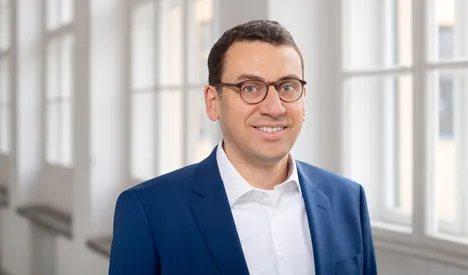Welcome, Professor Murad Alim
New@CIT |
What have been the most important stages in your academic career?
I first started studying computer science and continued in the field of physics and mathematics in Alexandria, in Karlsruhe, at the École normale supérieure Paris and at the Ludwig-Maximilians-Universität Munich (LMU). After my PhD in mathematical physics at LMU (2009), I worked at the Hausdorff Center in Bonn and subsequently at Harvard University as a postdoc and lecturer.
From 2016, I headed an Emmy Noether group and most recently held an interim professorship at the Mathematics Department in Hamburg before moving to Heriot-Watt University and the Maxwell Center in Edinburgh as Associate Professor of Mathematical Physics in 2024.
What are your main areas of research?
I conduct research in the field of mathematical physics at the interface between theoretical high-energy physics and pure mathematics. Within mathematics, my main focus is on complex geometry, with close connections to algebraic geometry, algebra, representation theory and number theory.
A central topic of my work is quantum geometry. Here, insights from physics are used to develop new mathematical structures that describe the phenomena of quantum theories.
What are you most looking forward to in your new position at the TUM?
I am very much looking forward to the exchange with the students. In the first few weeks, I have already experienced a great deal of interest and an impressive motivation. In particular, I am excited to further develop the links between theoretical physics and mathematics through joint research projects at the TUM. I am also looking forward to future collaborations and working together beyond my own field of research.
What was your biggest “aha” moment in your scientific career?
I still remember one particularly intense “aha” moment very vividly: I had been looking for a certain differential equation for years, but had been unable to find it. In a geometric and physical context, this equation would determine infinitely many quantities, which are otherwise very difficult or impossible to compute, in one go.
And then, all of a sudden, a new impulse enabled me to derive the equation. It was so clear and simple that I could hardly believe that it had remained unknown until then. I finally published the derivation of the equation as my shortest paper so far.
What is at the top of your personal bucket list?
My two daughters once said to me: “Dad, when you grow up, you want to write books, don't you?” The obvious choice would be books about my own field of research or textbooks on new lectures. But I think it's just as important to write books about science for the general public. Perhaps a novel could come along later.
I was able to realize another item on my wish list right after I started at TUM: In March, I had the opportunity to perform on stage at a science slam in Ulm. I will never forget the energy and the direct feedback from the live audience.
